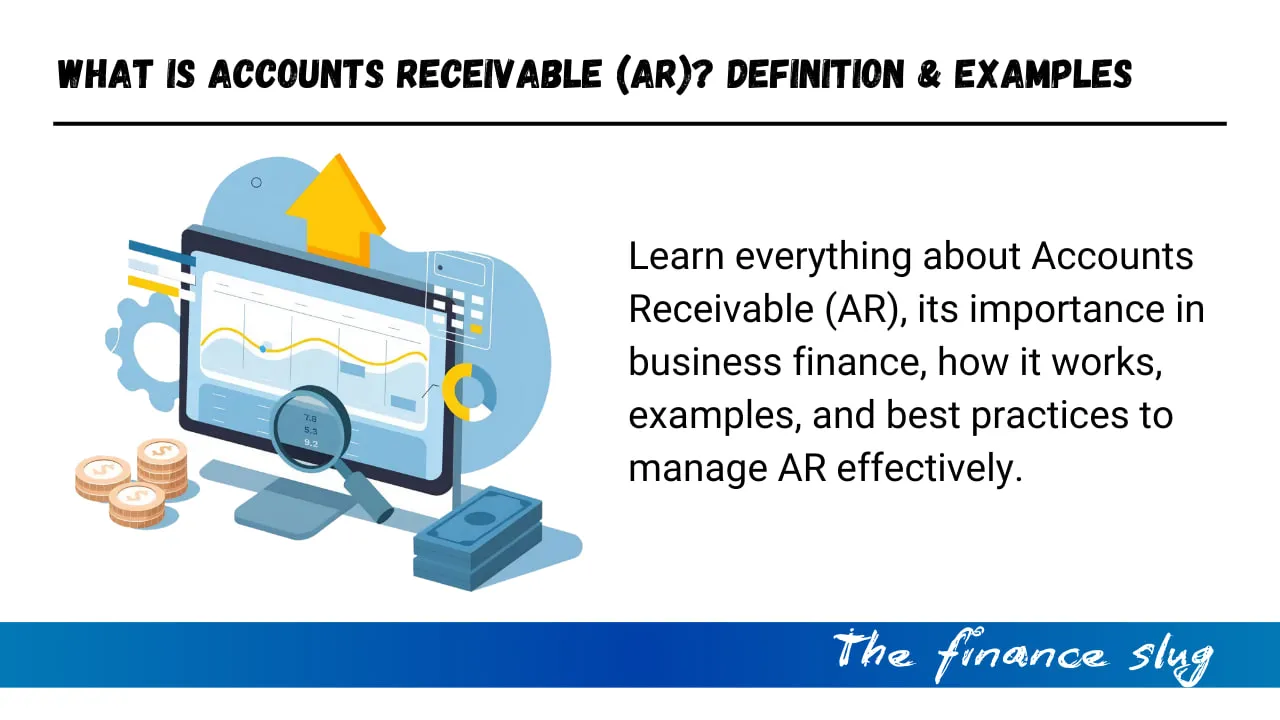
- Introduction to Accounts Receivable (AR)
- What is Accounts Receivable (AR)?
- Why is Accounts Receivable Important?
- How Does Accounts Receivable Work?
- Accounts Receivable vs. Accounts Payable
- Best Practices for Managing Accounts Receivable
- How to Calculate Accounts Receivable Turnover Ratio?
- Common Challenges in Accounts Receivable Management
- The Future of Accounts Receivable Management
- Conclusion
- Frequently Asked Questions (FAQs)
Introduction to Accounts Receivable (AR)
In the world of business finance, the term Accounts Receivable (AR) plays a critical role. Simply put, AR refers to the money a company is owed by its customers for goods or services delivered but not yet paid for. It is recorded as a current asset on the balance sheet and represents a company’s ability to generate future cash flow.
For businesses, efficient AR management ensures steady cash flow and reduces financial risks. But what exactly is Accounts Receivable, and how can businesses manage it effectively? Let’s explore!
What is Accounts Receivable (AR)?
Accounts Receivable (AR) refers to the outstanding invoices a company has or the money owed to it by customers. When a business sells goods or services on credit, it records the transaction as an AR entry in its accounting books.
Key Characteristics of AR:
- It is classified as a current asset on the company’s balance sheet.
- It represents credit sales and is expected to be paid within a short period (usually 30–90 days).
- AR is essential for maintaining working capital and business liquidity.
- It is different from Accounts Payable (AP), which refers to the money a company owes to its suppliers.
Example:
A software company provides a $5,000 service to a client on credit with a 60-day payment term. Until the payment is received, this amount is recorded as Accounts Receivable.
Why is Accounts Receivable Important?
1. Cash Flow Management
Effective AR management ensures that businesses receive payments on time, preventing cash flow problems. Late payments can impact a company’s ability to cover operating expenses like salaries and rent.
2. Business Growth
Offering credit to customers increases sales and builds strong client relationships. However, without a proper AR strategy, it can lead to bad debts.
3. Financial Health Indicator
A company with high AR but slow collection may face liquidity issues. On the other hand, a well-managed AR means a company efficiently converts credit sales into cash.
4. Impact on Financial Statements
AR affects key financial statements:
- Balance Sheet: Recorded as a current asset.
- Income Statement: Impacts revenue recognition.
- Cash Flow Statement: Shows AR collection patterns.
How Does Accounts Receivable Work?
The AR process involves multiple steps:
- Sale on Credit: A business sells products/services and issues an invoice.
- Invoice Recording: The amount is recorded in the AR ledger.
- Payment Terms: Customers agree to pay within a specified period (e.g., Net 30 days).
- Collection Process: The business follows up to ensure timely payment.
- Payment Receipt: Once paid, the AR balance decreases, and cash increases.
Accounts Receivable vs. Accounts Payable
| Feature | Accounts Receivable (AR) | Accounts Payable (AP) |
|---|---|---|
| Definition | Money owed to a company | Money owed by a company |
| Type | Asset | Liability |
| Impact on Cash Flow | Increases cash flow | Decreases cash flow |
| Example | A client owes $5,000 | Business owes $2,000 to supplier |
Best Practices for Managing Accounts Receivable
1. Establish Clear Credit Policies
Define who qualifies for credit, payment terms, and credit limits to reduce payment risks.
2. Send Invoices Promptly
Delayed invoicing leads to delayed payments. Use automated invoicing tools for efficiency.
3. Offer Multiple Payment Options
Provide flexible payment methods like bank transfers, credit cards, and online payments to speed up collections.
4. Set Up a Follow-Up System
Use reminders and follow-up emails to ensure timely payments. Late payment penalties can also encourage customers to pay on time.
5. Monitor AR Aging Reports
Regularly analyze Aging Reports to identify overdue invoices and take action to recover payments.
6. Outsource Collections if Necessary
If outstanding debts pile up, businesses can hire a collection agency to recover payments.
How to Calculate Accounts Receivable Turnover Ratio?
The Accounts Receivable Turnover Ratio (ART) helps measure how efficiently a company collects payments.
Formula:
ART=Net Credit Sales/Average Accounts Receivable
Example Calculation:
If a business has $200,000 in net credit sales and an average AR balance of $40,000, then:
ART=200,000/40,000=5
This means the company collects its AR five times per year. A higher ratio indicates efficient collection, while a lower ratio suggests collection issues.
Common Challenges in Accounts Receivable Management
1. Late Payments
Customers delaying payments can disrupt cash flow. Implementing penalties for late payments can help.
2. Bad Debts
Some customers may never pay. Businesses must set aside a bad debt reserve for such cases.
3. Disputes & Errors
Incorrect invoices or contract misunderstandings can delay payments. Clear communication and accurate invoicing are essential.
4. High Collection Costs
Chasing unpaid invoices consumes resources. Automation and outsourcing can reduce costs.
The Future of Accounts Receivable Management
1. Automation & AI
Businesses are increasingly using AI-powered software to manage AR efficiently, reducing human errors and speeding up collections.
2. Blockchain for Secure Transactions
Blockchain technology ensures secure, tamper-proof transactions, improving transparency in credit sales.
3. Digital Payment Integration
More businesses are integrating digital wallets, cryptocurrency, and instant payment solutions for faster collections.
Conclusion
Accounts Receivable (AR) is a vital component of a company’s financial health. Efficient AR management ensures steady cash flow, reduces financial risks, and strengthens business relationships. By implementing best practices like automated invoicing, clear credit policies, and proactive follow-ups, businesses can optimize their AR process and improve financial stability.
Want to improve your AR management? Start using automated tools today to enhance your cash flow and business growth!
Also Read : Accounts Payable Turnover Ratio: Formula, Importance & Calculation
Frequently Asked Questions (FAQs)
1. What is the difference between AR and revenue?
Revenue represents total income from sales, while AR refers to unpaid invoices yet to be collected.
2. How long should a company keep AR records?
Most businesses keep AR records for at least 7 years for tax and audit purposes.
3. What happens if customers don’t pay their AR?
Unpaid AR turns into bad debt, which may be written off as a loss in financial statements.
4. Can AR be used as collateral for loans?
Yes, businesses can sell AR (factoring) or use it as collateral for financing.
5. How can small businesses improve AR collections?
Small businesses can improve AR collections by offering early payment discounts, automated reminders, and multiple payment options.
Stock Market Crash Today: A Bloodbath on Monday – What You Need to Know
Published on financeslug.xyz The global financial markets are reeling from a massive sell-off, and Indian…
Wall Street Bonuses Reach Record $47.5 Billion in 2024, Up 34% from Previous Year
How to Convert Delimited CSV Data into Columns in Excel
CSV (Comma-Separated Values) files are widely used for data exchange, but when opened in Excel,…
Harvard University Announces Free Tuition for Families Earning $200K or Less
Harvard’s New Tuition-Free Policy: What You Need to Know Harvard University has unveiled a groundbreaking…
Eli Lilly’s 1.8B Dollar Investment in Weight Loss Drugs
Ireland’s Weight-Loss Drug Boom: A Game-Changer for Economy and Healthcare Ireland is witnessing a surge…
Forever 21 Files for Bankruptcy Again: The End of an Era in Fast Fashion?
Forever 21, once a staple in American malls and a leader in the fast-fashion industry,…







